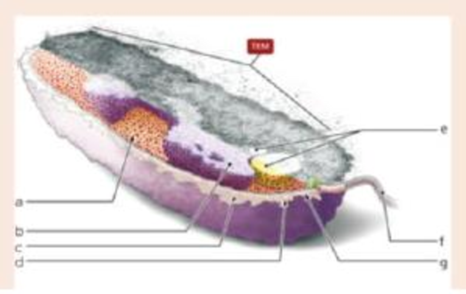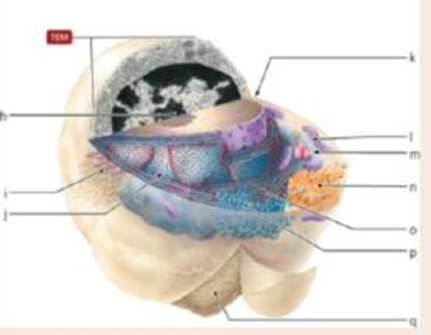
Microbiology with Diseases by Body System (5th Edition)
5th Edition
ISBN: 9780134477206
Author: Robert W. Bauman Ph.D.
Publisher: PEARSON
expand_more
expand_more
format_list_bulleted
Concept explainers
Textbook Question
Chapter 3, Problem 1VI
Label the structures of the following prokaryotic and eukaryotic cells. With a single word or short phrase, explain the function of each structure.


Expert Solution & Answer
Want to see the full answer?
Check out a sample textbook solution
Students have asked these similar questions
9. Chicken combs in chickens is an example where you see interactions between genes.
See potential genotypes and phenotypes below. Which genotype, when mated to a
rose comb chicken, will produce progeny that are 50% walnut comb and 50% pea comb?
walnut
(RRPP)
walnut
(RrPP)
pea
(rrPP)
walnut
(RRPP)
walnut
(RrPp)
pea
(rrPp)
rose
rose
single
(RRPP)
(Rrpp)
(rrpp)
Describe a compound light microscope and its importance in microbiology (2) examples of at least two microbes viewed under a compound light microscope and their general characteristics (note: the microbes you choose do not need to be the ones outlined in the above tutorial video) and (3) at least one source you used for the information included in your infographic.
Price of
visit
Number of
visits
$700
0
$600
[1
$500
2
$400
3
$300
4
00000
The Table blow gives the demand curve for doctor visits for Elena. If the price of a doctor's visit is $600, and Elena does not have health insurance, she will visit the doctor
times. If Elena obtains 50% coinsurance (the company pays 50% of the medical bill, Elena pays 50%), then Elena will visit the doctor times.
1; 2
0; 3
0; 2
1;4
2; 1
Chapter 3 Solutions
Microbiology with Diseases by Body System (5th Edition)
Ch. 3 - Prob. 1TMWCh. 3 - In 1985, an Israeli scientist discovered the...Ch. 3 - Why is a pilus a type of fimbria, but a flagellum...Ch. 3 - Why is the microbe illustrated in Figure 3.2 more...Ch. 3 - The Big Game College sophomore Nadia is a star...Ch. 3 - When the bacterium Escherichia coli is grown in a...Ch. 3 - Prob. 6TMWCh. 3 - Why do scientists consider bacterial and archaeal...Ch. 3 - Why did scientists in the 19th and early 20th...Ch. 3 - Why do some scientists consider archaea, which are...
Ch. 3 - Why are eukaryotic glycocalyces covalently bound...Ch. 3 - Many antimicrobial drugs target bacterial cell...Ch. 3 - Colchicine is a drug that inhibits microtubule...Ch. 3 - A cell may allow a large or charged chemical to...Ch. 3 - Which of the following statements concerning...Ch. 3 - A 9 + 2 arrangement of microtubules is seen in...Ch. 3 - Which of the following is most associated with...Ch. 3 - Which of the following is not associated with...Ch. 3 - Which of the following is true of Svedbergs? a....Ch. 3 - Which of the following statements is true? a. The...Ch. 3 - Prob. 8MCCh. 3 - Bacterial flagella are ______________. a. anchored...Ch. 3 - Prob. 10MCCh. 3 - A Gram-negative cell is moving uric acid across...Ch. 3 - Gram-positive bacteria _______________. a. have a...Ch. 3 - Endospores ________________. a. are reproductive...Ch. 3 - Prob. 14MCCh. 3 - Dipicolinic acid is an important component of...Ch. 3 - Match the structures on the left with the...Ch. 3 - Match the term on the left with its description on...Ch. 3 - Label the structures of the following prokaryotic...Ch. 3 - Label each type of flagellar arrangement.Ch. 3 - A scientist who is studying passive movement of...Ch. 3 - Describe (or draw) an example of diffusion down a...Ch. 3 - Sketch, name, and describe three flagellar...Ch. 3 - Prob. 3SACh. 3 - The term fluid mosaic has been used in describing...Ch. 3 - A local newspaper writer has contacted you, an...Ch. 3 - Prob. 6SACh. 3 - Compare bacterial cells and algal cells, giving at...Ch. 3 - Contrast a cell of Streptococcus pyogenes (a...Ch. 3 - Differentiate among pili, fimbriae, and cilia,...Ch. 3 - Prob. 10SACh. 3 - Prob. 11SACh. 3 - Prob. 12SACh. 3 - What is the function of glycocalyces and fimbriae...Ch. 3 - Prob. 14SACh. 3 - Compare and contrast three types of passive...Ch. 3 - Prob. 16SACh. 3 - Prob. 17SACh. 3 - Prob. 18SACh. 3 - Prob. 1CTCh. 3 - Methylene blue binds to DNA. What structures in a...Ch. 3 - Prob. 3CTCh. 3 - Prob. 4CTCh. 3 - A researcher carefully inserts an electrode into...Ch. 3 - Prob. 6CTCh. 3 - An electron micrograph of a newly discovered cell...Ch. 3 - An entry in a recent scientific journal reports...Ch. 3 - Prob. 9CTCh. 3 - Prob. 10CTCh. 3 - Prob. 11CTCh. 3 - Prob. 12CTCh. 3 - Prob. 13CTCh. 3 - Prob. 14CTCh. 3 - Using the following terms, fill in the following...
Knowledge Booster
Learn more about
Need a deep-dive on the concept behind this application? Look no further. Learn more about this topic, biology and related others by exploring similar questions and additional content below.Similar questions
- P 200 150- 100 50 w/instrance/ w/insurance 2 100 Demand Assume that the white curve (labeled "Demand") represents an individual's true demand for this particular health care service. The coinsurance associated with insurance option 1 (in blue) is likely _. 0000 100% 25% 50% 0%arrow_forwardUse the figure below. Bob and Nancy have the same income and total utility.. willingness to pay for an insurance premium will be lower than because they are. risk- averse. Total utility Current utility Bob's utility Nancy's utility 0000 Bob; Nancy; less Nancy; Bob; less Nancy; Bob; more Bob; Nancy; more Current Income incomearrow_forwardConsider the figure below. Suppose the true price of a health care service is P1. Suppose further that the individual has obtained insurance that has a fixed copayment for this particular service. The copayment is represented by price P2. represents the quantity of the service the individual would consume without insurance. quantity of the service the individual would consume with the insurance. Health Care Service represents the P. P₂ a Q1;Q2 Q2; Q3 Q1; Q3 Q3; Q1 Q2; Q1 फ f Q ८ g d h Q3\D 7Q 00000arrow_forward
- The table shows the utility Jordan receives at various income levels, but they do not know what their income will be next year. There is a 15% chance their income will be $25,000, a 20% chance their income will be $35,000, and a 65% chance their income will be $45,000. We know that Jordan is Income $25,000 Utility 2,800 30,000 3,200 35,000 3,500 40,000 3,700 45,000 3,800 ☐ none of the above 0 000 risk taker (lover) because their marginal utility of income is increasing risk neutral because their marginal utility of income is constant risk averse because their marginal utility of income is decreasing risk neutral because their marginal utility of income is decreasingarrow_forwardOOOO a d+e d a+b+c Consider the figure below. Suppose the true price of a health care service is P1. Suppose further that the individual has obtained insurance that has a fixed copayment for this particular service. The copayment is represented by price P2. The social loss from moral hazard if the individual has copayment P2 is represented graphically by the area(s): Health Care Service P. a No 4 ८ e g Q2 Q3 Darrow_forwardOOO O The table shows the utility Jordan receives at various income levels, but they do not know what their income will be next year. There is a 15% chance their income will be $25,000, a 20% chance their income will be $35,000, and a 65% chance their income will be $45,000. We know that Jordan's expected income is. Their utility from their expected income is_ Income $25,000 Utility 2,800 30,000 3,200 35,000 3,500 40,000 3,700 45,000 3,800 $45,000; 3,800 $40,000; 3,700 $25,000; 2,800 $35,000; 3,500 $30,000; 3,200arrow_forward
- Question 1 Classify the Bird Mark 7; how is it: Powered Triggered Cycled Classify brid mark 7 Powered: By gas (oxygen) Triggered: Negative Pressure, caused by the patient’s inspiratory effort Cycled: The machine stops delivering gas and allows for exhalationarrow_forwardHypothetical "pedigree" for Sickle Cellarrow_forwardwould this be considered a novel protein and if not how can I fix it so it is and can you draw the corrections pleasearrow_forward
- In as much detail as possible, hand draw a schematic diagram of the hypothalamic-pituitary- gonad (HPG) axis in the human male. Be sure to include all the relevant structures and hormones. You must define all abbreviations the first time you use them. Please include (and explain) the feedback loops.arrow_forwardA negligence action was brought by a mother against a hospital on behalf of her minor daughter. It alleged that when the mother was 13 years of age, the hospital negligently transfused her with Rh-positive blood. The mother's Rh-negative blood was incompatible with and sensitized by the Rh-positive blood. The mother discovered her condition 8 years later during a routine blood screening ordered by her healthcare provider in the course of prenatal care. The resulting sensitization of the mother's blood allegedly caused damage to the fetus, resulting in physical defects and premature birth. Did a patient relationship with the transfusing hospital exist?arrow_forward18. Watch this short youtube video about SARS CoV-2 replication. SARS-CoV-2 Life Cycle (Summer 2020) - YouTube.19. What is the name of the receptor that SARS CoV-2 uses to enter cells? Which human cells express this receptor? 20. Name a few of the proteins that the SARS CoV-2 mRNA codes for. 21. What is the role of the golgi apparatus related to SARS CoV-2arrow_forward
arrow_back_ios
SEE MORE QUESTIONS
arrow_forward_ios
Recommended textbooks for you
 Human Biology (MindTap Course List)BiologyISBN:9781305112100Author:Cecie Starr, Beverly McMillanPublisher:Cengage Learning
Human Biology (MindTap Course List)BiologyISBN:9781305112100Author:Cecie Starr, Beverly McMillanPublisher:Cengage Learning Biology Today and Tomorrow without Physiology (Mi...BiologyISBN:9781305117396Author:Cecie Starr, Christine Evers, Lisa StarrPublisher:Cengage Learning
Biology Today and Tomorrow without Physiology (Mi...BiologyISBN:9781305117396Author:Cecie Starr, Christine Evers, Lisa StarrPublisher:Cengage Learning Biology 2eBiologyISBN:9781947172517Author:Matthew Douglas, Jung Choi, Mary Ann ClarkPublisher:OpenStax
Biology 2eBiologyISBN:9781947172517Author:Matthew Douglas, Jung Choi, Mary Ann ClarkPublisher:OpenStax Concepts of BiologyBiologyISBN:9781938168116Author:Samantha Fowler, Rebecca Roush, James WisePublisher:OpenStax College
Concepts of BiologyBiologyISBN:9781938168116Author:Samantha Fowler, Rebecca Roush, James WisePublisher:OpenStax College

Human Biology (MindTap Course List)
Biology
ISBN:9781305112100
Author:Cecie Starr, Beverly McMillan
Publisher:Cengage Learning



Biology Today and Tomorrow without Physiology (Mi...
Biology
ISBN:9781305117396
Author:Cecie Starr, Christine Evers, Lisa Starr
Publisher:Cengage Learning

Biology 2e
Biology
ISBN:9781947172517
Author:Matthew Douglas, Jung Choi, Mary Ann Clark
Publisher:OpenStax

Concepts of Biology
Biology
ISBN:9781938168116
Author:Samantha Fowler, Rebecca Roush, James Wise
Publisher:OpenStax College
Biology - Intro to Cell Structure - Quick Review!; Author: The Organic Chemistry Tutor;https://www.youtube.com/watch?v=vwAJ8ByQH2U;License: Standard youtube license